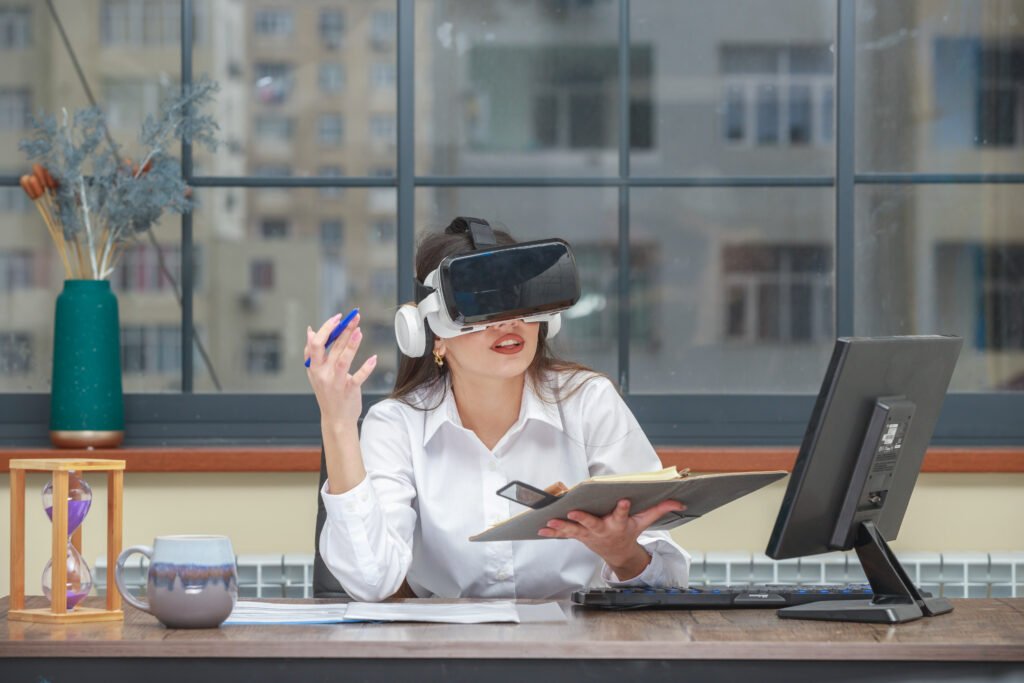As a game-changing technological advancement, smart glasses have made it harder to distinguish between the real and virtual worlds. As Augmented Reality (AR) advances, these future eyewear technologies can be used as effective tools to boost productivity in a variety of professions. The Field-Programmable Gate Array (FPGA) is one important technological advancement that powers the effectiveness of augmented reality in smart glasses. The capabilities of Smart Glasses are expanded by this technology, which allows for real-time processing, increased power efficiency, and better user experiences.
As we explore the relationship between FPGA and smart glasses, it’s critical to comprehend the larger picture. Wearable technology called “smart glasses” has small screens that project digital data onto the user’s actual surroundings, fusing the virtual and physical worlds together in a seamless manner. Significant progress has been made in the field of augmented reality in smart glasses, moving from novelty to real-world uses in industries like manufacturing, healthcare, and education.
In this analysis, we will examine the function of FPGA in smart glasses and how it plays a key part in augmenting reality. Because of its programmability and flexibility, FPGA is a key component in maximizing the processing power needed for AR applications. The connections between FPGA and smart glasses will be discussed, along with the effects they have on productivity and the overall state of technological progress.
Smart Glasses and Augmented Reality
A. Definition of Augmented Reality:
The technology known as augmented reality (AR) modifies the physical world by superimposing virtual or digital features on top of it, improving the user’s perception and interaction with it. Augmented Reality (AR) augments and improves the real-world experience, in contrast to Virtual Reality (VR), which submerges users in a fully virtual environment. The delivery of augmented reality (AR) is best facilitated via smart glasses, which provide users with a hands-free, contextually integrated display that enhances their daily activities.
B. Applications of AR in Smart Glasses:
Industrial Use Cases:
a. Maintenance and Repair: AR-capable Smart glasses give technicians visual assistance in real-time by superimposing maintenance instructions and other data on the equipment they are servicing. This shortens downtime and facilitates quicker troubleshooting.
b. Training and Simulation: Businesses use augmented reality (AR) in smart glasses to train employees by letting them practice difficult tasks in a virtual setting. This immersive training method lowers the possibility of mistakes in practical situations while improving skill development.
c. Logistics and Warehousing: AR-capable smart glasses make logistics operations easier by offering visual clues for order picking, inventory control, and warehouse movement. Supply chain operations become more accurate and efficient as a result.
Consumer Applications:
a. Navigation and Travel: Smart Glasses with AR-enhanced navigation provide users with a more intuitive and contextual navigation experience by superimposing directional arrows, points of interest, and real-time information about their surroundings.
b. Social Interaction: With augmented reality (AR) overlaying digital details about others in the user’s field of vision, such as their name, occupation, or common hobbies, smart glasses can improve social interactions and create deeper connections.
Healthcare and Education:
a. Medical Training: In order to give medical professionals a hands-on learning experience, augmented reality (AR) in smart glasses is used in medical education for realistic simulations, surgical training, and seeing anatomical components.
b. Assistive Technologies: AR-enabled smart glasses can help those who are blind or visually impaired by giving them access to real-time environmental information, object recognition, and autonomous navigation.
Role of FPGA in Smart Glasses
Smart Glasses rely significantly on cutting-edge technologies to provide an engaging augmented reality experience because of its ability to seamlessly integrate digital information into the user’s visual field. The Field-Programmable Gate Array (FPGA) is one of these technologies that is essential to the effectiveness and efficiency of Smart Glasses in a variety of applications. It offers several advantages.
A. Accelerating Processing Power:
Parallel Processing Capabilities: Tasks requiring parallel processing can be effectively handled by FPGAs. This translates to the capacity to analyze several streams of data concurrently in the context of smart glasses, which is essential for creating intricate AR overlays in real-time.
Low Latency Performance: FPGA architecture’s parallelism lowers latency, guaranteeing that AR content is rendered quickly. This is necessary to keep the user’s experience fluid and engaging.
B. Real-time Data Processing for AR Applications:
Sensor Fusion and Environmental Awareness: Numerous sensors, such as gyroscopes, accelerometers, and cameras, are frequently included in smart glasses. Real-time data fusion from various sensors is made possible by FPGA, which gives the device the ability to dynamically comprehend and react to its surroundings.
Object Recognition and Tracking: FPGA’s capability to process data in real-time enhances the Smart Glasses’ ability to recognize and track objects in the user’s field of view. This is particularly valuable in industrial applications, where the glasses can provide information about machinery or products.
C. Power Efficiency and Performance Benefits:
Optimized Energy Consumption: Power consumption can be decreased by using FPGAs since they can be designed to perform particular tasks more quickly than general-purpose CPUs. Longer battery life, which is important for user acceptance and practicality, is the outcome in the context of smart glasses.
Customization for AR Workloads: Developers can customize the hardware architecture to meet the unique needs of augmented reality applications because of FPGAs’ programmability. The Smart Glasses provide a responsive and energy-efficient augmented reality experience because of their enhanced performance as a result of personalization.
FPGA Implementation in Smart Glasses
Field-Programmable Gate Arrays (FPGAs), which provide a flexible platform for executing intricate and real-time processing operations, are crucial in defining the capabilities of Smart Glasses. Careful consideration of both hardware and software elements is required for the integration of FPGA technology in Smart Glasses.
A. Hardware Architecture Considerations
Processing Power Enhancement:
- FPGA’s parallel processing capabilities significantly boost the processing power of Smart Glasses.
- Customizable hardware architecture allows for tailored solutions, optimizing performance for specific AR applications.
Power Efficiency:
- FPGAs are known for their power efficiency, a critical factor in wearable devices like Smart Glasses.
- Low power consumption ensures prolonged battery life, a key determinant for user adoption and practicality.
Sensor Integration:
- FPGA facilitates seamless integration with various sensors (gyroscopes, accelerometers, cameras) commonly found in Smart Glasses.
- Real-time data from sensors can be processed efficiently, enhancing the overall AR experience.
B. Software Development for FPGA in AR
Programmability and Flexibility:
- FPGA’s inherent programmability allows developers to customize algorithms for specific AR applications.
- Flexibility in reprogramming ensures adaptability to evolving AR requirements.
Real-Time Data Processing:
- FPGA’s parallel architecture enables real-time processing of sensor data, minimizing latency in AR applications.
- The instantaneous rendering of augmented content contributes to a seamless and immersive user experience.
Algorithm Optimization:
- Developers can optimize AR algorithms for FPGA architectures, maximizing the efficiency of image recognition, object tracking, and spatial mapping.
- This optimization results in enhanced AR performance and responsiveness.
C. Challenges and Solutions in Implementing FPGA in Smart Glasses
Size and Form Factor:
- Miniaturization of FPGA components is essential for integration into the compact form factor of Smart Glasses.
- Advanced packaging techniques and system-on-chip (SoC) solutions address space constraints.
Heat Dissipation:
- FPGA operations may generate heat, requiring efficient heat dissipation mechanisms to maintain user comfort.
- Thermal management solutions, such as heat sinks and temperature sensors, are employed to address this challenge.
Cost Considerations:
- FPGA technology can be cost-intensive, impacting the overall affordability of Smart Glasses.
- Advances in FPGA manufacturing and increased adoption may contribute to cost reduction over time.
Future Trends and Innovations
A. Emerging Technologies in Smart Glasses and AR:
Advancements in Display Technology:
- Exploration of new display technologies such as holographic displays or improved light field displays.
- Integration of higher resolution and more immersive displays for enhanced AR experiences.
Sensor Innovations:
- Development of more advanced sensors for improved environmental understanding.
- Integration of additional sensors for enhanced gesture recognition and interaction.
Connectivity and 5G:
- Utilization of 5G networks to enable faster and more reliable data transfer.
- Integration of edge computing for reduced latency in AR applications.
B. Potential Advancements in FPGA Technology:
Increased Processing Power:
- Evolution of FPGA architectures to provide even higher processing capabilities.
- Integration of specialized processing units within FPGAs for specific AR tasks.
Energy Efficiency:
- Focus on developing more energy-efficient FPGA designs for prolonged battery life.
- Exploration of low-power modes to optimize energy consumption during idle states.
Enhanced Programmability:
- Improvements in programming languages and tools for easier FPGA development.
- Increased accessibility for developers without extensive FPGA expertise.
C. Integration of AI and Machine Learning in AR with FPGA:
On-Device AI:
- The growing trend of implementing AI algorithms directly on FPGAs within Smart Glasses.
- Use of AI for real-time object recognition, scene understanding, and context-aware applications.
Adaptive Learning:
- Integration of machine learning models that adapt to user behavior and preferences.
- Personalized AR experiences based on user interactions and historical data.
Collaboration of FPGA and Neural Processing Units (NPUs):
- Synergies between FPGAs and dedicated NPUs for more efficient AI processing.
- Combined FPGA-NPU architectures to handle complex AR scenarios.
D. Ethical Considerations and User Acceptance:
Privacy Safeguards:
- Implementation of robust privacy features to protect user data in AR applications.
- User-centric design that prioritizes data security and transparency.
Social Implications:
- Exploration of the impact of AR on social interactions and norms.
- Ethical guidelines for AR content creation and sharing.
User Education and Acceptance:
- Initiatives to educate users on the benefits and potential risks of AR technology.
- Strategies for increasing user acceptance through positive experiences and practical applications.
The future of FPGA in Smart Glasses and AR holds exciting possibilities, with ongoing technological advancements poised to redefine user experiences, improve performance, and address ethical considerations for widespread adoption.
Challenges and Considerations
Field-Programmable Gate Arrays (FPGAs) enable Augmented Reality (AR) in Smart Glasses, which offers a promising new avenue for increased productivity. But there are other obstacles and issues to take into account with this integration, including practical, ethical, and technical ones.
A. Technical Challenges:
Hardware Limitations: Even with FPGAs’ versatility, hardware constraints still need to be taken into consideration. Overcoming these limitations is necessary to optimize FPGA designs for Smart Glasses since there is a delicate balance to be struck between processing power and energy economy.
Integration Complexity: It can be technically difficult to effectively integrate FPGA technology into the small form factor of smart glasses. A major design problem is making sure that the hardware maintains excellent functioning without compromising the device’s weight or ergonomics.
Software Development: It takes specialist knowledge to create software that makes the most of FPGA in augmented reality applications. Innovation may be hampered by the lack of developers who are skilled in both FPGA programming and creating augmented reality applications.
B. Ethical Considerations:
Privacy Concerns: AR applications often involve capturing and processing real-world data. Ensuring the privacy of individuals, especially in public spaces, raises ethical concerns. Striking a balance between providing valuable AR experiences and respecting personal privacy is a critical consideration.
Data Security: With the integration of FPGA, the handling of sensitive data becomes even more crucial. Protecting user data from potential breaches or unauthorized access is a paramount concern that must be addressed to build trust in these technologies.
User Consent: The immersive nature of AR can blur the lines between the virtual and real worlds. Obtaining clear and informed consent from users regarding the collection and use of their data is an ethical imperative.
C. User Adoption Challenges:
Learning Curve: The adoption of Smart Glasses with FPGA-powered AR capabilities may be hindered by the learning curve associated with using such advanced technology. Users, especially in industrial settings, need training to maximize the potential benefits.
Cost Considerations: The cost of implementing FPGA technology in Smart Glasses can be a barrier to widespread adoption. Companies and individuals may be hesitant to invest in these devices, particularly if the perceived benefits do not outweigh the financial outlay.
Cultural Acceptance: Societal acceptance of AR technology varies across cultures. Overcoming cultural barriers and perceptions of AR as intrusive or distracting is essential for widespread adoption.
Conclusion
In summary, augmented reality (AR) has entered a new era of increased productivity thanks to the combination of FPGA technology and smart glasses. Real-time data processing and processing power acceleration are made possible by FPGAs, which are widely recognized for their programmability and versatility.
Dynamic integration has revolutionized various sectors by providing innovative solutions that boost decision-making processes, decrease errors, and optimize workflows. Though user adoption issues and ethical concerns need to be resolved to assure responsible and widespread integration, the further development of both FPGA and Smart Glasses technologies promises even more intelligent AR applications in the future.


![What is FPGA Introduction to FPGA Basics [2023] computer-chip-dark-background-with-word-intel-it](https://fpgainsights.com/wp-content/uploads/2023/06/computer-chip-dark-background-with-word-intel-it-300x171.jpg)









